

Les Grenats Almandins de Plélauff - Côtes d'Armor - France - Eric GloaguenEric.Gloaguen@wanadoo.fr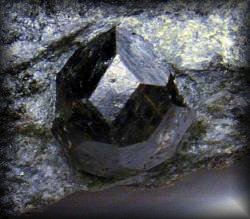 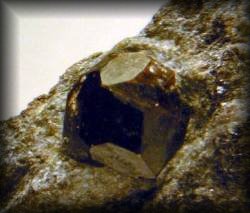 Photos - ©1999 F.Hède
Photos - ©1999 F.HèdeIn the South of the department of Côtes d'Armor ( France ), there is a deposit of quartzite containing magnificents garnets Almandin, rhombododécaèdrics of 48 faces.
Garnets are dark red, non-transparent with very net faces strengthened by a beautiful glassy brightness, when they are in a zone where the quartzite is slightly altered. This particular aspect results, a priori, from a little alteration of surface of garnets. Indeed, when garnets result from healthy zones of quartzites, not only the colour is different (the red is more clear), but glassy brightness becomes absent, replaced by an aspec rather fat. The size of these garnets, which count among the most beautiful of the Massif Armoricain, is spread out of 3mm in 30mm of about diameter.
As this zone of grounds is very covered by the vegetation, it is especially during the ploughingsof the fields that one can find fragments of quartzite interesting. But I also found sympathetic blocks in border of some fields and even in a prairie. Garnets in photo under the title result from a block found in a prairie and that itstays there thrones on my fireplace!, Here it is: 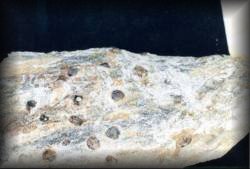 Photo ©1999 E.Gloaguen
Photo ©1999 E.GloaguenOne does not see too well on the photo but the crystals are of excellentquality and numerous!. Then here are the same roughly plan which result from the other half of the block (They make all 13mm of diameter): 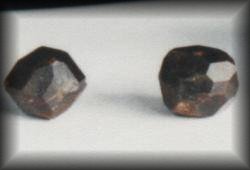  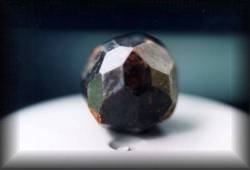 Photos ©1999 E.Gloaguen I had the chance of well-prepared this block because the quartzite was altered superficially on about 5cm of thickness that helped me to extract garnets and it is that gave this first-rate glassy brightness. Regrettably my expeditions are not always fruitful because the quartzite is extremely hard and, very often, garnets break when extraires is tried. With no altered blocks it is often disaster. After some week-ends on the site I noticed that the size of garnets varied according to the place and that the same garnets are found in parallel bands all 1500 m, it allows me now to refine my searches! Indeed, the last garnets that I found make 30 mm in diameter for the biggest!. I have not made there yet photos regrettably, but in here is an example which results from P.Aviron's collection: 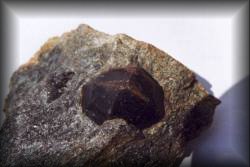 Photo ©1999 E.Gloaguen
Photo ©1999 E.GloaguenFaces on this detail 30 mm in diameter(room 30 mm in diameter) about but no glassy brightness are seen sharply. I continue to think that it is becausethis garnet was not slightly altered. Indeed, by thinking well you see that the quartzite has no same colour above and below the level or are the garnet, change it is produced only on about 15 mm in depth and did not so touch the garnet. It so has no glassy brightness. The last garnets that I found are in a more altered quartzite and also more foliée so garnets are brilliant but more deformed. My next objective is so to find big garnets not deformed with a beautiful glassy brightness!. 
|